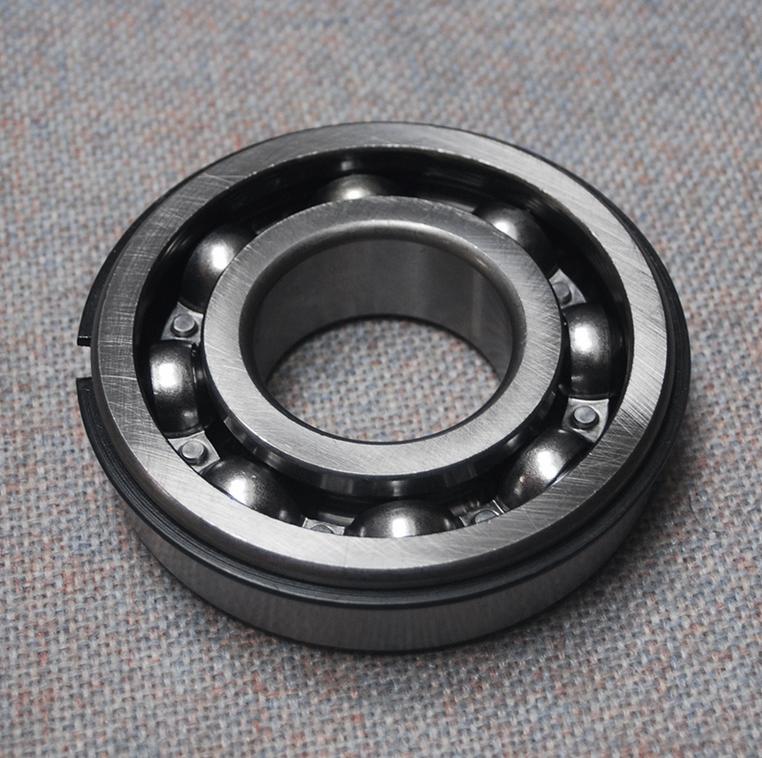Hello Peezee,
For the recognized expert to make that comment, he's not much of an expert.
At the back end of the Gearbox is an integral oil pump. Notwithstanding that the oil pressure generated is quite low, its oil pressure, nonetheless. The fibre washer that locates in that hole resists the oil pressure being exerted on the gasket joint between the front of the gearbox and the rear surface of the Bell Housing.
The fibre washer available from at least one of the well known parts suppliers was too large by a long shot. Make sure that the fibre washer you get is a firm, interference fit in it's corresponding bore, otherwise you will end up with an oil leak.
The gasket for the front of the Gearbox needs to be placed behind the Circlip of the front bearing. When applying the gasket, I use Permatex Gasket Sealant on both sides of the gasket. I see that the Front Bearing used is the shielded type. This is not a bad thing, so long as the shield for the side of the bearing on the inside of the Gearbox has been removed. If not, that front bearing won't get much, if any lubrication at all. I use this type of bearing, as anything to limit the amount of oil getting to the joint between the front of the Gearbox and the Bell Housing is a good thing, but the shield on the inside of the Gearbox must be removed.
The correct Rear Bearing hasn't been available for a long time and many of these so called experts don't seem to understand that the only thing that drives the Oil Pump is the clamping force applied by the Companion Flange nut and often make the mistake of backing the nut off to the previous slot in the Castellated Nut if the split pin doesn't assemble when the nut is tight. This nut should be torqued up good and tight and if the split pin won't assemble, material should be removed from the interfacing surface of the nut, or the thick washer until it does with the nut torqued up tight. There is no torque figure specified form this nut, but I use a similar torque to that specified for the differential Companion Flange Nut (140 lb/ft). The Thread Diameter is circa the same and 140lb/ft torque is still way below the torque specified for that size thread.
The correct bearing has practically no radius between the face and the bore of the inner race of the bearing (see the following picture).

The Oil Pump Drive is simply a circa 5mm wall thickness sleeve that abuts the face of the rear bearing and is made to be driven by the Main Shaft rotating due to the clamping force of the Companion Flange nut.
You can also note that even with this correct bearing, yielding the maximum surface contact with the Oil Pump Drive Sleeve, there is still evidence of slippage between the Oil Pump Drive Sleeve and the face of the bearing. This would be due to the Companion Flange Nut not being tight enough, hence the importance of having this nut tightened correctly and not backing it off to facilitate fitting the split pin.
The following picture is typical of the bearing supplied by most of the well known parts suppliers and bearing outlets; note the size of the radius between the face and bore of the inner race (circa 4mm). With this type of bearing, the margin of contact between the face of the bearing and the face of the Oil Pump Drive Sleeve is only circa 1mm (radius value). Although friction in largely independent of surface area, pressure isn't. This small contact margin quickly deforms and once started, deteriorates exponentially.

The brand of bearing I've found to give the greatest amount of contact area to the Oil Pump Drive Sleeve is KSM. I also mask up the Oil Pump Drive Sleeve, prior to assembly and bead blast the face that interfaces with the face of the bearing. This give a surface finish that retains a miniscule amount of bearing retaining fluid that I use between the face of the bearing and the face of the Oil Pump Drive Sleeve.
Regards,
Bill
.



